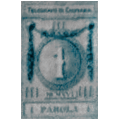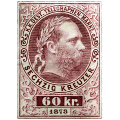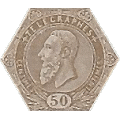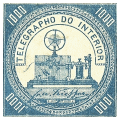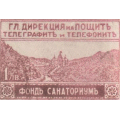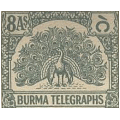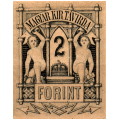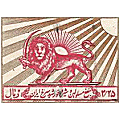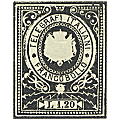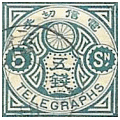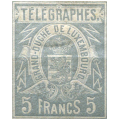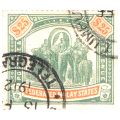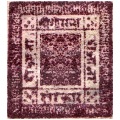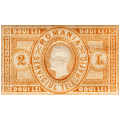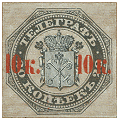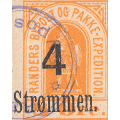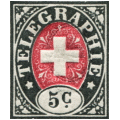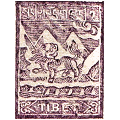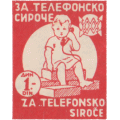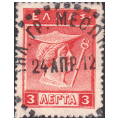| अनुवाद |
Übersetzen sie |
WORKING
|
Traduisez |
ترجم |
| перевести |
Traduca |
Traduzca |
翻译 |
|
Telegraph stamps of the World
Click here for a site-map. |
Select currency. Default = GBP (1.0)
|

I have brought these prices up to date and added currency selection.
CheckList Setup |
|
|
|
BELGIUM.
Steve Hiscocks wrote:
On 23 December 1845 the Belgian Government authorized the setting up of a telegraph line along the railway between Brussels and Anvers by the
British company Wheatstone and Cooke. This line, with telegraph offices at Brussels, Malines and Anvers, was opened on 9 September 1846. In 1850
the Government bought the line and extended the system to link up with the Berlin and Paris systems and, by 1853, with Great Britain by submarine
cable. Up to 1865 telegrams were apparently prepaid in cash with no stamps of any sort, the administration of the telegraphs being separate
from that of postage. On 1 December 1865 a telegraph form incorporating an embossed 50c stamp for 20 words was introduced. The two first
adhesives, 50c and 1F, were introduced on 7 January 1866 and use of either these on a form lacking the embossed stamp or use of the embossed form
was allowed until 8 August 1876. After that date only telegraph stamps could be used until they were abandoned on 1 March 1911. Thereafter
postage stamps were used.
My note:
Anvers may be better known to some as Antwerp. Malines is also known as Mechelen.
Belgium uses the languages of French and Flemish. Place names and official notices are generally given in both languages.
Additionally English names for places may be different to both the French and Flemish names.
Can anyone supply an image of this embossed 50c stamp ?
1866 (7 January) Leopold I. White wove un-watermarked paper. Perf. 13½
Steve Hiscocks noted (see below) that there were a number of reprints of these, and that there were problems distinguishing them.
I have recently been given information on the differences (see below), but it depends on shade and paper thickness.
Specimens and used examples are more likely to be originals than unused examples.
I am providing many images, in the hope that a pattern may emerge.
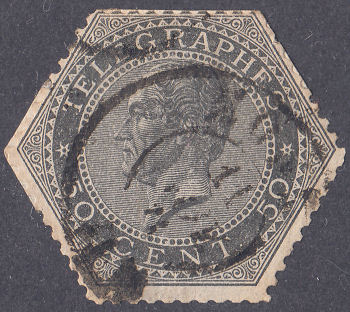 |
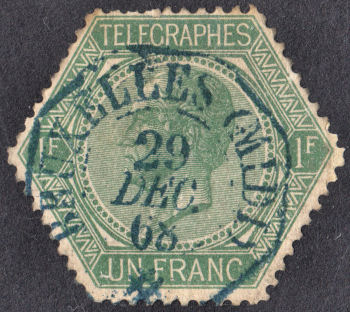 |
| Type 1 50c - H1 Used |
Type 1 1F - H2 Used |
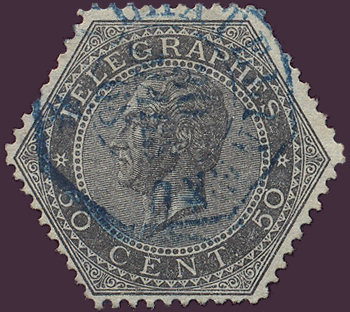 |
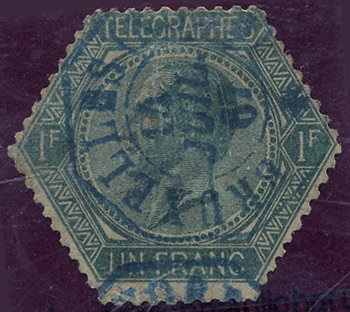 |
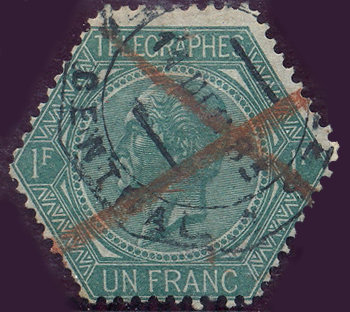 |
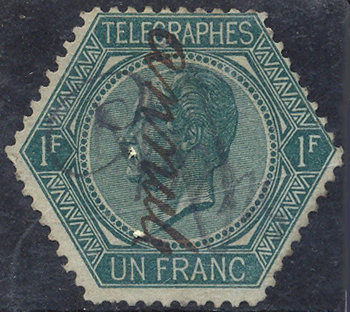 |
| Type 1 50c - H1 Used - from RL |
Type 1 1F - H2 Used - from RL |
Type 1 1F - H2 Used - from RL |
Type 1 1F - H2 Used - from RL |
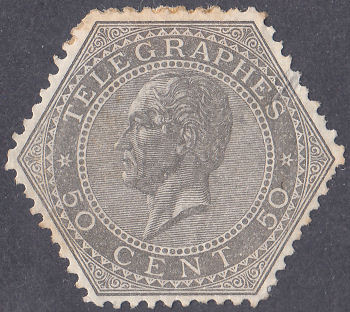 |
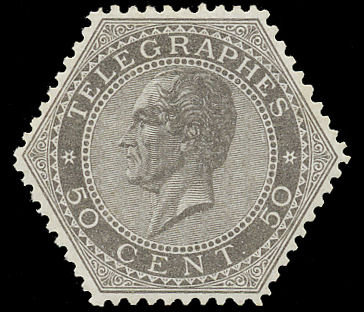 |
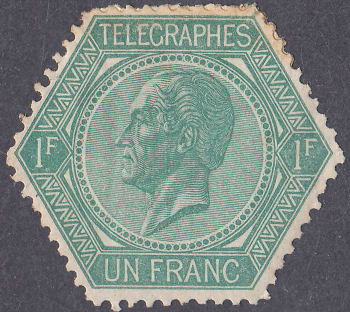 |
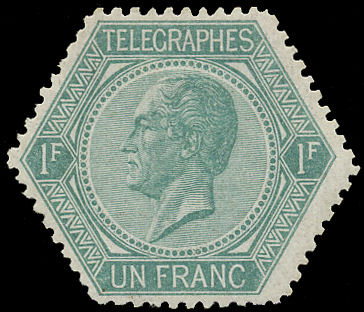 |
| Type 1 50c - H1 Reprint ? (see below) |
Type 1 50c - H1 courtesy of philamundi on eBay. |
Type 1A 1F - H2 Reprint ? (see below) |
Type 1A 1F - H2 courtesy of philamundi on eBay. |
 |
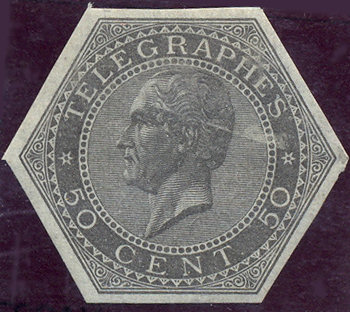 |
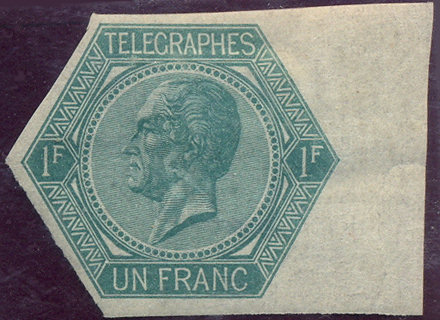 |
| Type 1 50c - H1a - From RL |
Type 1 50c - H1b - From RL |
Type 1 1F - H2b - From RL |
 |
 |
 |
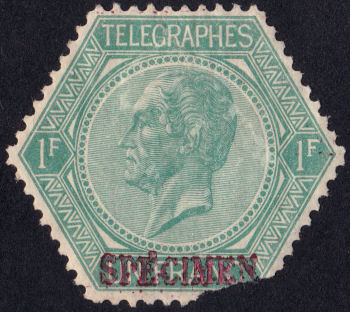 |
| Type 1 50c - H1 Specimen in red |
Type 1 50c - H1 Specimen in blue from RL |
Type 1 50c - H2 Specimen in red from RL |
Type 1 50c - H2 Another specimen in red (mine) |
For what it is worth, here are some 1200 dpi closeups of some of mine shown above.
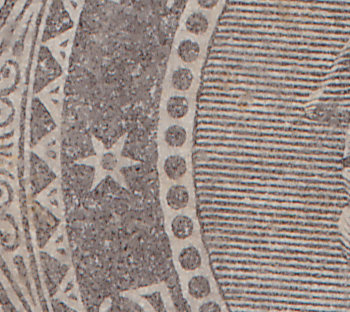 |
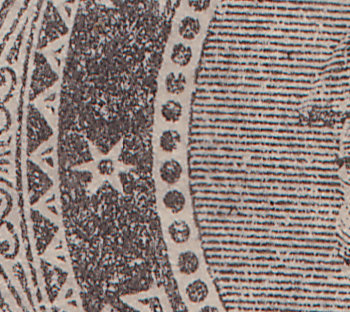 |
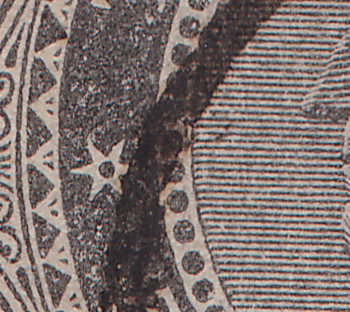 |
| 1200dpi closeup 50c - H1 Reprint ? |
1200dpi closeup 50c - H1 Specimen in red |
1200dpi closeup 50c - H1 Used |
 |
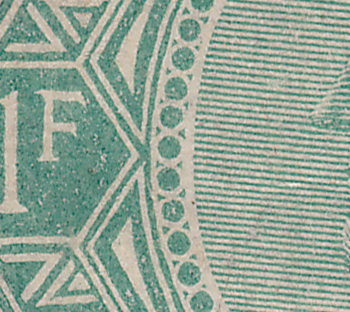 |
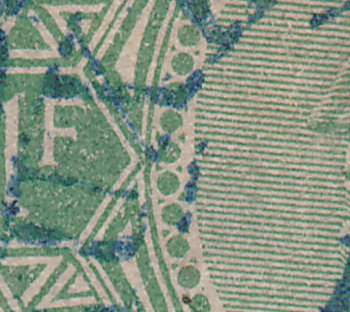 |
| 1200dpi closeup 1Fr - H2 Reprint ? |
1200dpi closeup 1Fr - H2 Specimen in red |
1200dpi closeup 1Fr - H2 Used |
| Hisc. |
Type |
Description |
Mint |
Used |
| H1 |
1 |
50c grey |
125.00 |
75.00 |
| H1a |
1 |
grey-black |
140.00 |
100.00 |
| H1b |
1 |
imperf. |
60.00 |
- |
| H1c |
1 |
on thick paper |
140.00 |
100.00 |
| H2 |
1A |
1F green |
175.00 |
110.00 |
| H2a |
1A |
yellow-green |
190.00 |
120.00 |
| H2b |
1A |
imperf. |
60.00 |
- |
| H2c |
1A |
on thick paper |
180.00 |
120.00 |
Hiscocks added the following note:
Note. Reprints from the original blocks are also found. These would seem to be imperf.
and are listed as 'cut out' and 'in sheet' — priced £12 and £30 respectively
for either value. How these are distinguished from original imperf. varieties
when cut to shape is not clear. [1982 prices] |
There is a stamp catalogue produced in Belgium that lists the telegraph stamps. I have been sent a scan of part of it.
It is listed in French and Flemish. I am not sure of the date, but fairly recent with prices given in Euros.
It lists Specimens with overprint in black, blue or red on 50c grey and 1Fr green.
Then, surprisingly considering Hiscocks list,
for 1865 it lists imperforate 50c grey and 1Fr green on thin smooth paper.
This is followed for 1870-71 another printing on thick paper of 50c dark grey and 1Fr yellow green.
It then lists two reprints as being normally perforated, though I am told they also exist imperforate:
1897, large sheets (150 x 75 mm) pricing for cut-outs or for complete sheet - 50c brown grey and 1Fr green
1902, small sheets (90 x 55 mm) pricing for cut-outs or for complete sheet - 50c grey and 1Fr yellow green
For these last, I have no idea how many stamps there were on each sheet, but the pricing suggests only one or two.
? I bought an example of each described as "Reprinted on Glazed Paper".
The paper seems to be glazed about the same as the used example and the later set.
The Specimen though appears to be on unglazed paper and is a poorer quality
impression as a result. The 50c described as a reprint is on thinner paper,
|
|
An item described more fully below.
The image is unclear compared to the genuine ones.
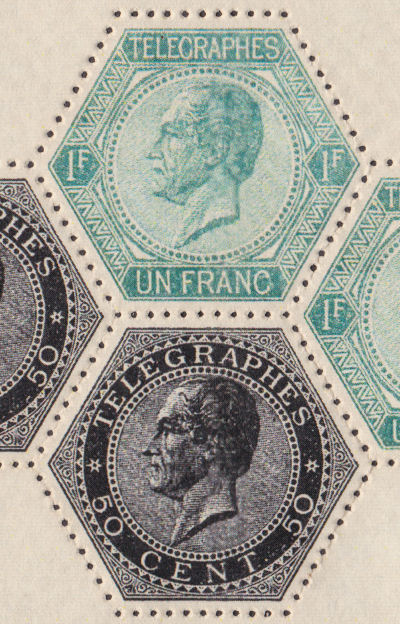 |
A 1200 dpi scan.
This looks like photogravure to my inexpert eye.
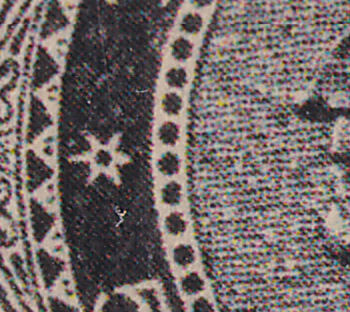 |
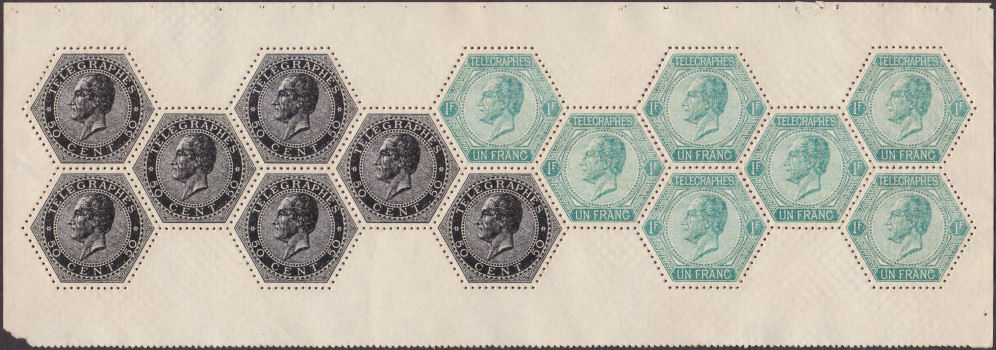
This appears to be a reprint or 'souvenir sheet', though clearly perforated with smaller holes having a guage of about 14. Image at 120dpi.
The 50c is black rather than grey. The 1F is a darker, bluer green. There is no gum. There is nothing printed on the back and the back has no markings,
though the paper seems to be lightly embossed with a dimpled pattern. Below is an enhanced image of the back.
I don't know if this results from part of the manufacturing process, bad storage, or is perhaps a deliberate distinguishing feature.
The complete miniature sheet measures 208 x 72mm.

Anyone have any information on this ?
1966 Centenary issue.
French and Flemish without perforations - from RL.
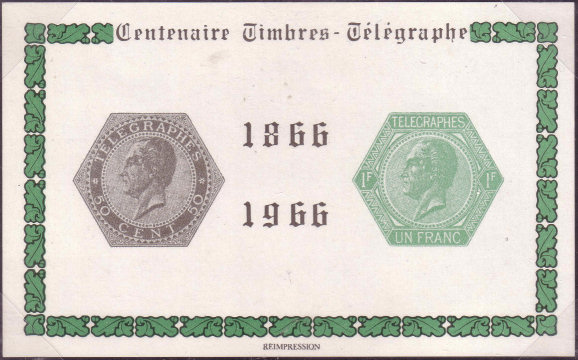

These are half my normal scale. They measure about 97 x 60mm.
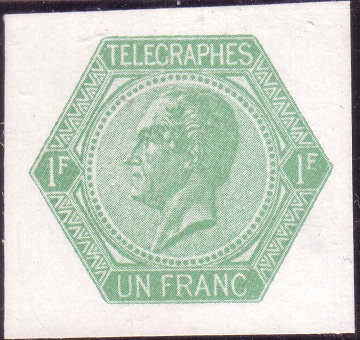
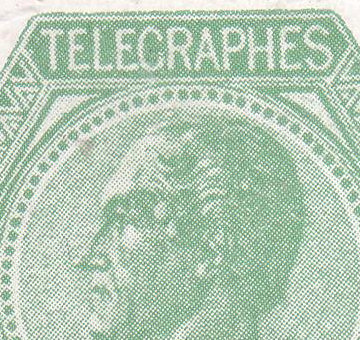
These appear to have been printed by photogravure, with the dots clearly visible
1871 (1 June) Leopold II. White wove un-watermarked paper. Perf. 13½
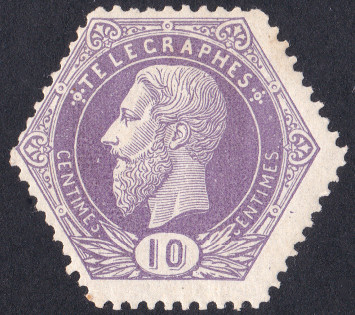 |
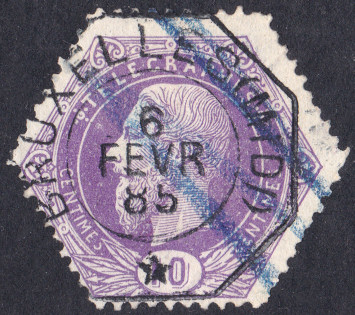 |
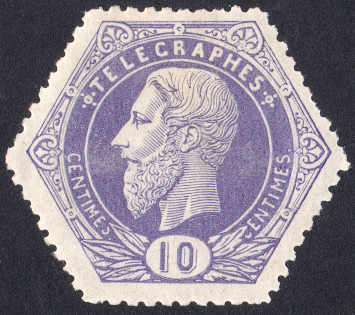 |
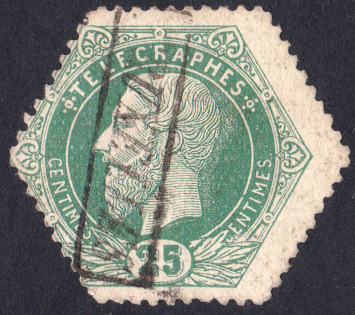 |
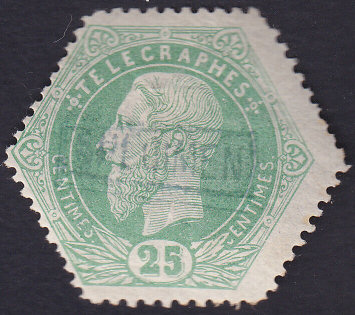 |
| Type 2 H3 - 10c |
Type 2 H3a - 10c |
Type 2 H3c - 10c |
Type 2 H4 - 25c |
25c specimen, courtesy of AsianStamp - (click for listing). |
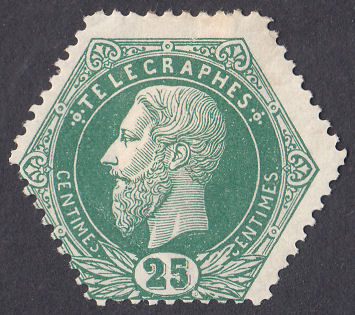 |
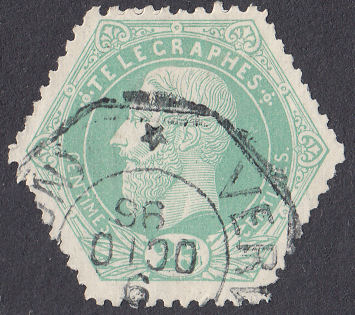 |
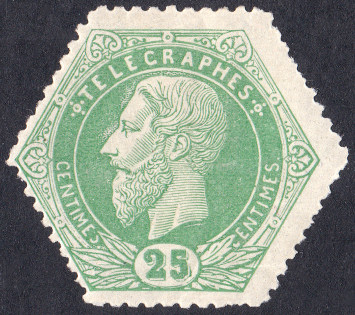 |
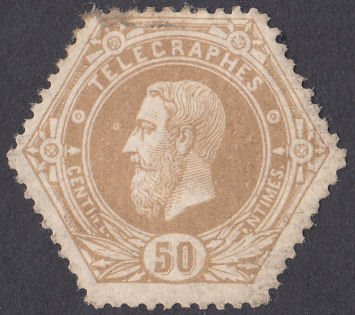 |
| Type 2 H4a - 25c |
Type 2 H4b - 25c |
Type 2 H4c - 25c |
Type 3 H5 - 50c |
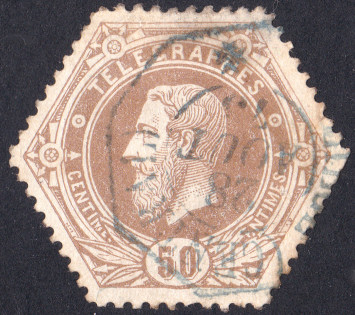 |
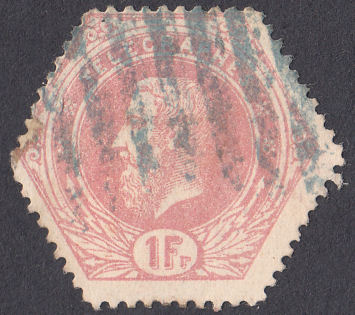 |
 |
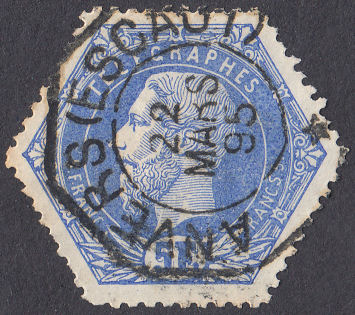 |
| Type 3 H5b - 50c |
Type 4 H6 - 1Fr |
Type 4 H6b - 1Fr |
Type 5 H7 - 5Fr |
| Hisc. |
Type |
Description |
Mint |
Used |
| H3 |
2 |
10c mauve (1.5.78) |
10.00 |
2.00 |
| H3a |
|
reddish violet |
12.00 |
2.00 |
| H3b |
|
No. 3(a) on chalky paper (1896) |
100.00 |
10.00 |
| H3c |
|
slate lilac |
10.00 |
2.00 |
| H4 |
2 |
25c dull blue-green (1.7.72) |
12.00 |
2.00 |
| H4a |
|
myrtle green |
20.00 |
2.50 |
| H4b |
|
pale bluish green |
12.00 |
2.00 |
| H4c |
|
yellow green |
12.00 |
2.00 |
| H5 |
3 |
50c ochre |
15.00 |
2.00 |
| H5a |
|
imperf. |
75.00 |
- |
| H5b |
|
brown |
20.00 |
2.00 |
| H5c |
|
orange |
200.00 |
100.00 |
| H6 |
4 |
1F rose |
30.00 |
2.00 |
| H6a |
|
deep rose (aniline) |
45.00 |
3.00 |
| H6b |
|
carmine-rose |
35.00 |
2.00 |
| H6c |
|
lilac-rose |
30.00 |
2.00 |
| H6d |
|
lilac-rose imperf. |
75.00 |
- |
| H7 |
5 |
5F ultramarine (1.5.78) |
250.00 |
2.00 |
| H7a |
|
imperf |
500.00 |
- |
| H7b |
|
Prussian blue |
350.00 |
20.00 |
| H7c |
|
Prussian blue imperf. |
350.00 |
50.00 |
1879 (1 October). New value and design. White wove un-watermarked paper. Perf. 13½
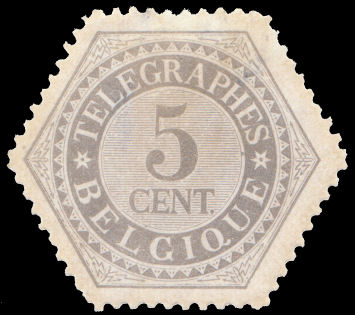 |
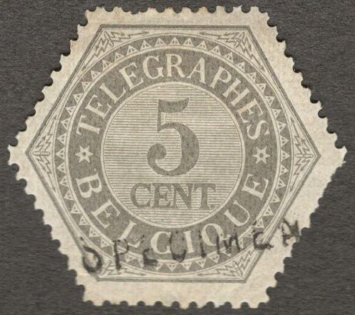 |
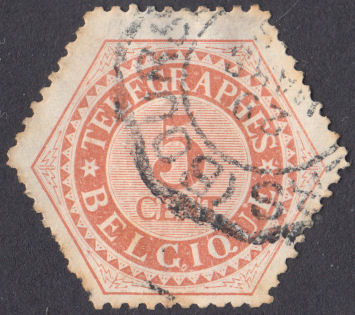 |
| Type 6 H8 - 5c |
H8a Specimen courtesy of AlphaOmegaPhilately on eBay.
(Click on image for listing) |
Type 6 H9 - 5c |
| Hisc. |
Type |
Description |
Mint |
Used |
| H8 |
6 |
5c grey |
20.00 |
5.00 |
| H8a |
|
dark grey |
25.00 |
6.00 |
| H9 |
6 |
5c brownish orange (9.3.91) |
25.00 |
4.00 |
Hiscocks added the following note:
Note.
Recent Belgian catalogues give the date of No. 9 as 1.3.93 but the change, with reference
to an official notice of 9.3.91, is reported in the American Philatelist' of June 1891. |
My note: H9 mint seems much harder to get than H8 mint.
The Michel Catalogue gives the date for this as 1/3/1893.
1889 (1 January). New type and format in sheets of 5 x 5. White wove un-watermarked paper. Perf. 14½ x 15½ or 14.
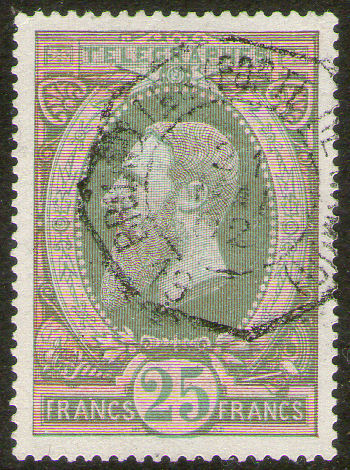
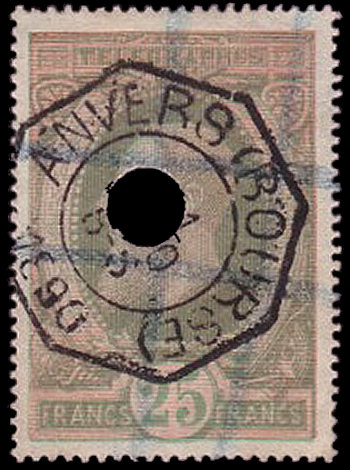
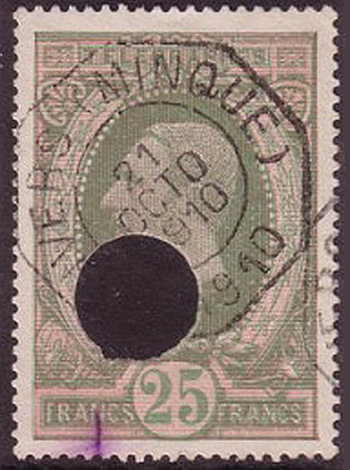
Type 7. one of mine, and two from RL of 1890 and 1910 with different sized punch holes.
Many were used at Anvers Bourse (Antwerp Stock Exchange).
| Hisc. |
Type |
Description |
Mint |
Used |
| H10 |
7 |
25F green and rose. (Perf. 14½ x 15½) |
300.00 |
40.00 |
| H10a |
|
perf. 14 |
30.00 |
18.00 |
| H10b |
|
imperf. (proof ) |
50.00 |
- |
The used price above is for hand-stamp cancelled copies.
Punched cancellations sell for about 15%.
John Barefoot points out that forgeries of these are reported. They are said to have an uneven pink security background.
Further information on them, ideally with an image, would be very welcome.
1888 (1 September) Leopold II in new design (lined background). White wove un-watermarked paper. Perf. 13½
Interestingly, these and later stamps have a capital 'R' on the beard. The engraver perhaps ?
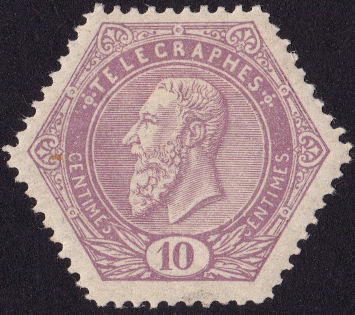 |
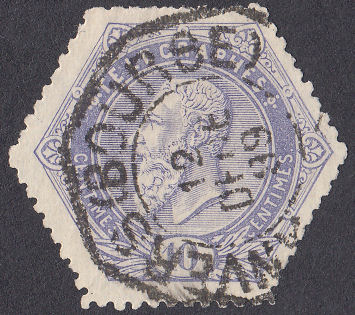 |
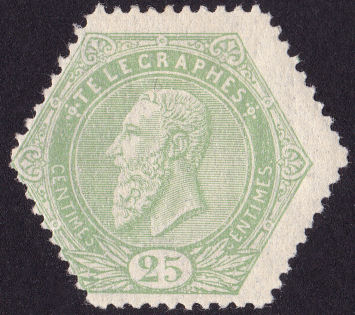 |
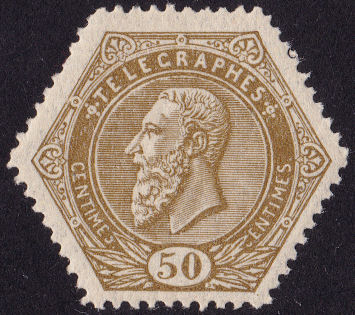 |
| Type 8 H11 - 10c |
Type 8 H11a - 10c |
Type 8 H12 - 25c |
Type 8 H13 - 50c |
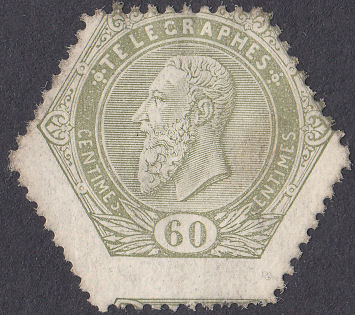 |
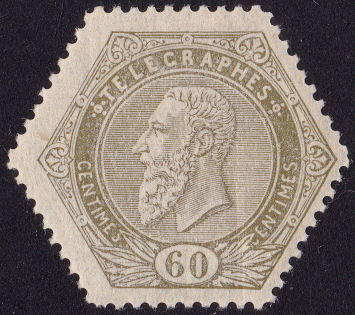 |
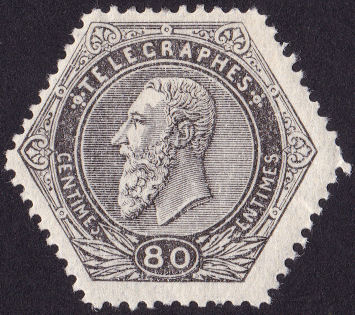 |
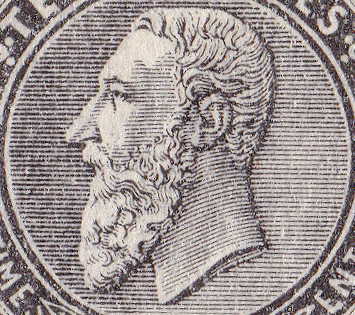 |
| Type 8 H14 - 60c |
Type 8 H14c ? - 60c |
Type (8) H15 - 80c |
' R ' in beard. |
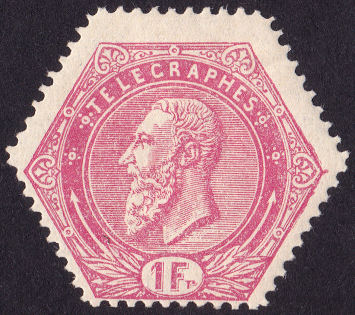 |
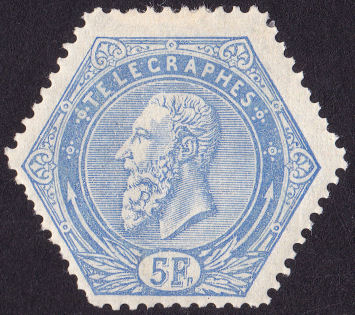 |
| Type 9 H16 - 1Fr |
Type 9 H17 - 5Fr |
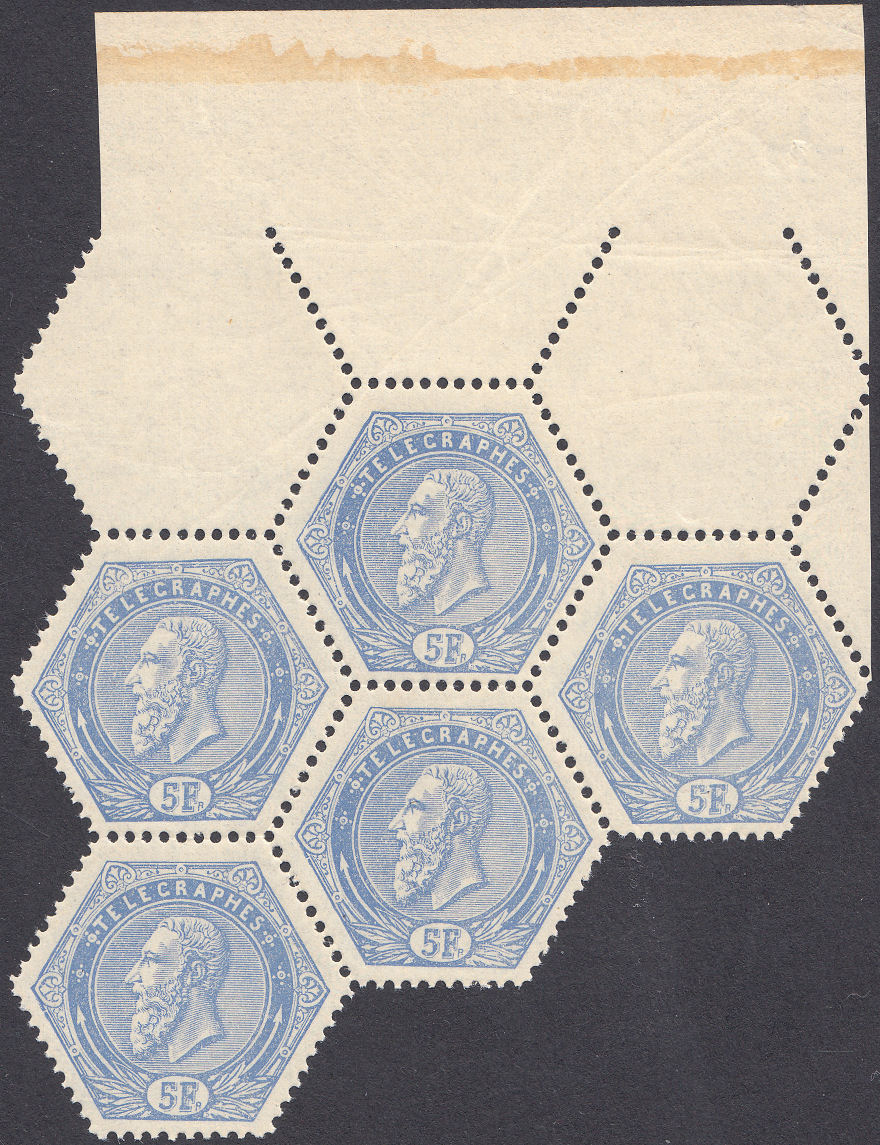
A block of the 5Fr Type 9 (H17). Some are reasonably well centred, others are not. |
|
| Hisc. |
Type |
Description |
Mint |
Used |
| H11 |
8 |
10c reddish purple (1899) |
4.00 |
3.00 |
| H11a |
|
grey-lilac |
20.00 |
6.00 |
| H12 |
8 |
25c yellow-green (1899) |
3.50 |
2.00 |
| H12a |
|
bluish green |
5.00 |
2.50 |
| H13 |
8 |
50c bistre (1899) |
0.60 |
0.50 |
| H13a |
|
brown-bistre |
0.75 |
0.50 |
| H14 |
8 |
60c olive-green |
1.00 |
0.50 |
| H14a |
|
imperf. |
35.00 |
- |
| H14b |
|
dark olive-green |
1.00 |
0.50 |
| H14c |
|
grey green (on chalky paper) |
25.00 |
10.00 |
| H15 |
(8) |
80c grey (1.4.97) |
2.50 |
2.00 |
| H15a |
|
grey-black |
2.50 |
2.00 |
| H16 |
9 |
1F bright rose(1899) |
1.00 |
1.00 |
| H17 |
9 |
5F blue (1899) |
1.25 |
1.20 |
Whilst there are many shades of this series and the 1871 series, most can
be put down to poor quality control rather than deliberate intention.
H11a is however an exception, being clearly distinct without
intermediate colours.
|
A strip of 6 x 5Fr stamps on a piece of form used in Saventhem (Zaventem) 17 September 1906 (Shown half size).

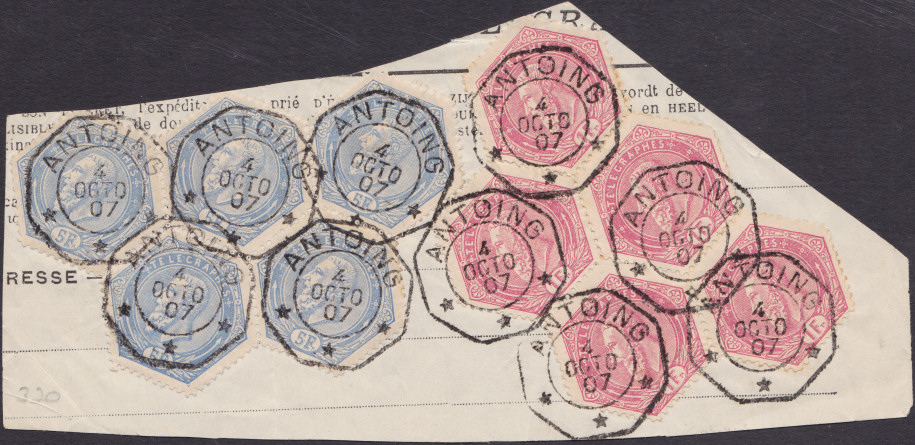
Another piece with 5 x 5Fr and 5 x 1Fr used in Antoing 4 October 1907 (again half size).
I am not sure how often 30 Francs was needed on these forms, but perhaps it is surprising that there was no 10 Franc value.
Hiscocks added the following 2 notes:
| Note 1.
The value on No. 15 is in white on black. |
| Note 2.
The use of telegraph stamps ended on 1 March 1911. |
Perfins.
Many of this series are known perfined.
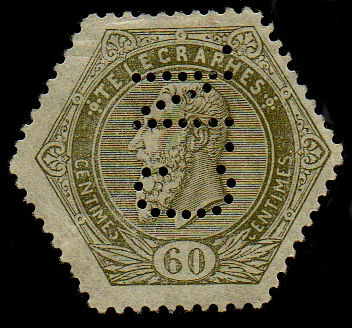
This is C.N. used by Comptoir National D'Escompte, Antwerp.
Note that Antwerp is known as Antwerpen in Flemish and Anvers in French.
More examples are shown on my Belgian Perfins page.
Telegraph Receipt Stamp.
This is actually a revenue stamp to pay for the receipt, rather than paying to send a telegram.
1897 (1 April). Issued in books with ten in horizontal strip, each attached to counterfoil as shown.
White wove un-watermarked paper. Perf. 11½ .
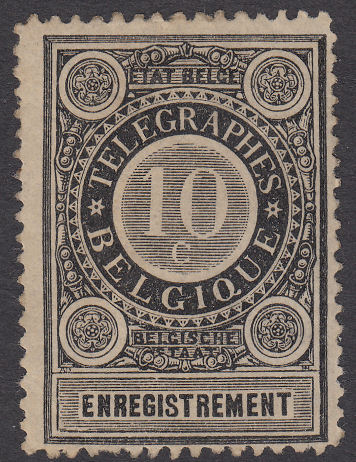
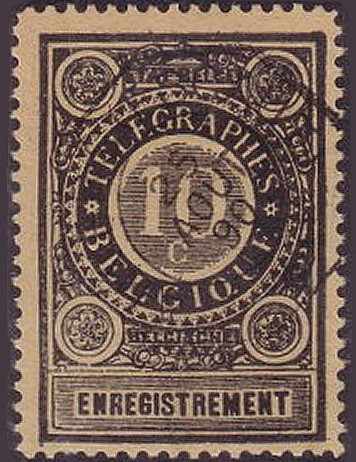
Type 10 - According to Hiscocks, Michel and Yvert et Tellier, these date from 1897, but the used example from RL is dated '90.
Presumably a date-stamp error, perhaps '06' inverted or '09' reversed.
| Hisc. |
Type |
Description |
With counterfoil |
Without counterfoil |
| Mint |
Used |
Mint |
Used |
| H18 |
10 |
10c black |
50.00 |
60.00 |
20.00 |
20.00 |
Type 10 with counterfoil (half size).

The gum was pasted (mostly) just on the stamp part.
Telegraph stamps were withdrawn at the beginning of March 1911.
.
Telephone Stamps 1 January 1891
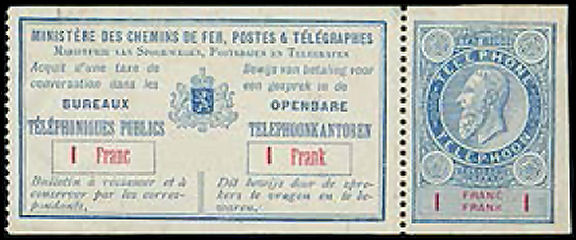 |
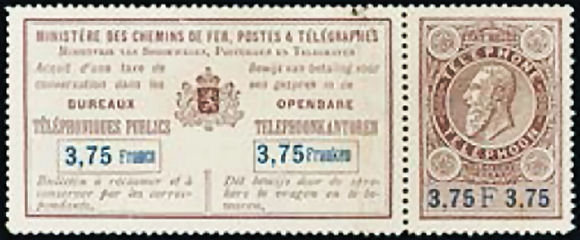 |
| H5a - only perforated between. |
H8 - perforated all around. |
These were engraved by A. Duns, whose initials appear in the frame just above the left-hand value. Images courtesy of Spink and Son.
A 30c example can be seen on Wikimedia Commons. The counterfoils are in the same colours as the stamps.
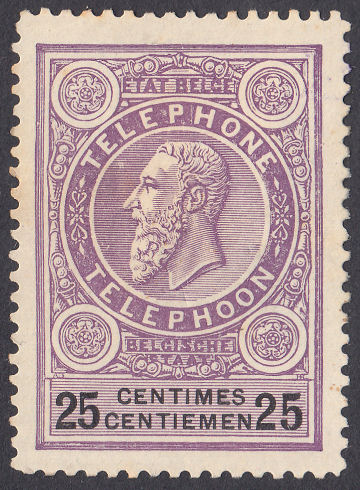 |
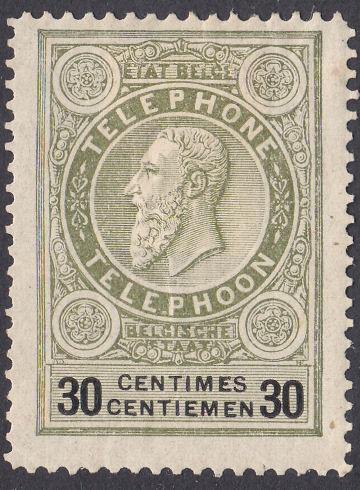 |
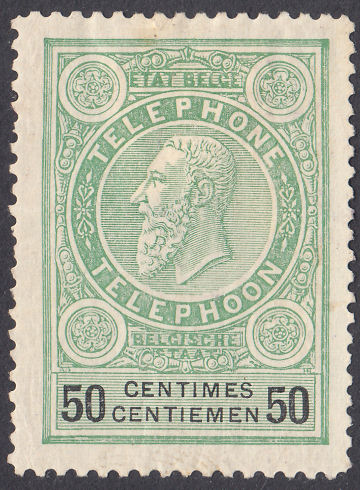 |
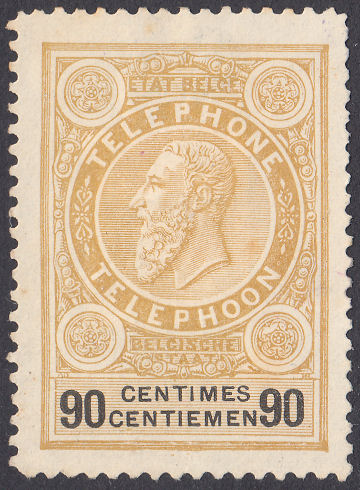 |
| H1 - 25c |
H2 - 30c |
H3 - 50c |
H4 - 90c |
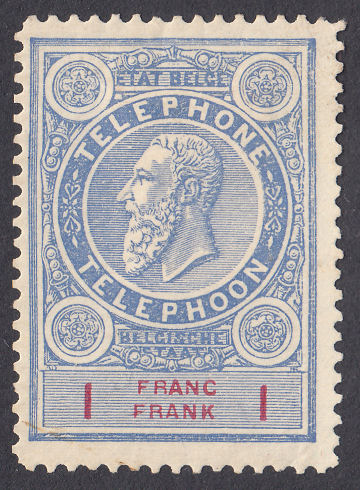 |
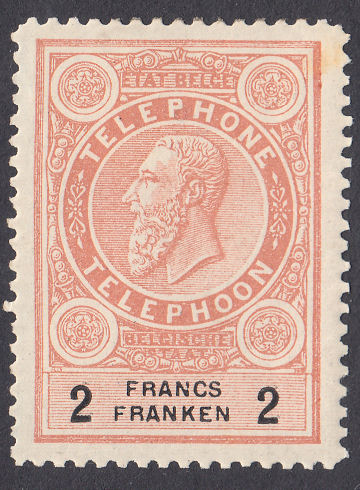 |
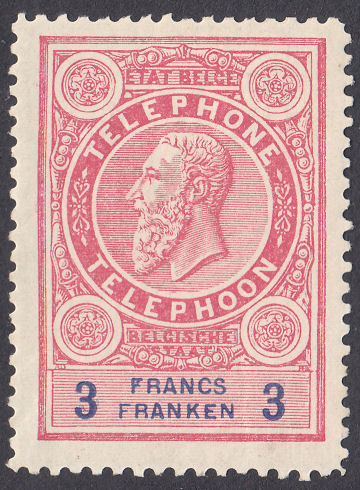 |
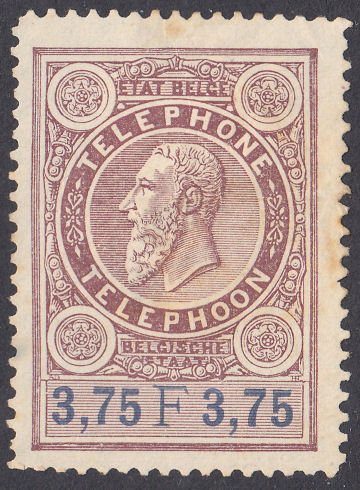 |
| H5 - 1Fr |
H6 - 2Fr |
H7 - 3Fr |
H8 - 3F75 |
Type 11. H1 to H8. Issued in books of 5, each with an attached counterfoil.
White wove paper Perf. 11½. No Watermark.
Values in second colour.
| Hisc. |
Type |
Description |
Mint + Cfl. |
Mint |
Used |
| H1 |
11 |
25c purple-brown (black) |
25.00 |
1.00 |
2.00 |
| H1a |
|
perf. only between stamp and label |
80.00 |
- |
- |
| H2 |
11 |
30c pale brown-olive (black) (1.4.92) |
25.00 |
1.00 |
2.00 |
| H3 |
11 |
50c dull green (black) |
25.00 |
1.00 |
2.00 |
| H3a |
|
perf. only between stamp and label |
80.00 |
- |
- |
| H4 |
|
90c brownish yellow (black) (1.4.92) |
28.00 |
1.00 |
2.00 |
| H5 |
11 |
1F blue (carmine) |
25.00 |
1.00 |
2.00 |
| H5a |
|
perf. only between stamp and label |
80.00 |
- |
- |
| H6 |
11 |
2F Indian red (black) (1.1.96) |
32.00 |
1.00 |
2.00 |
| H7 |
11 |
3F carmine (blue) |
32.00 |
1.00 |
3.00 |
| H7a |
|
perf. only between stamp and label |
80.00 |
- |
- |
| H8 |
|
3.75F brown (blue) (1.5.99) |
550.00 |
2.00 |
3.00 |
Hiscocks added the following 3 notes:
Note 1. The three price columns are respectively unused with counterfoil, unused without counterfoil,
and used (always without counterfoil). The stamps were printed in vertical strips of five with a
second strip, inverted, attached at the stamp side. It is therefore possible to find tête-bêche
pairs of the whole set and these sell for about £5 for each pair. |
Note 2. Use of these stamps ended on 11 July 1903 so the 3.75F was in use for a relatively short time.
It seems likely that all outstanding stock was sold off without counterfoils when their use was
abandoned resulting in the relative scarcity of those with counterfoils which could only have
been purchased earlier. |
Note 3. The first stamps, issued on 1 January 1891, were only perforated between stamp and counterfoil
and were otherwise imperforate. This variety is not found in those values introduced later.
This would suggest that used copies imperforate on two or three sides should have existed but
I have not seen them reported and they may all have been destroyed. |
Hiscocks does not price used counterfoils, but they appear to be on the market and are certainly collectible.
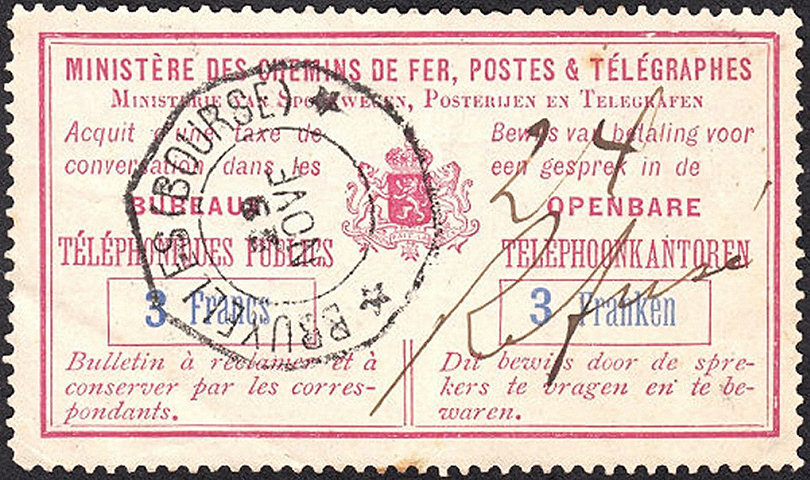
The image above is taken from Wikimedia Commons.
Images below show that gum was pasted onto the parts that needed it. The back of the receipt part did not need it..

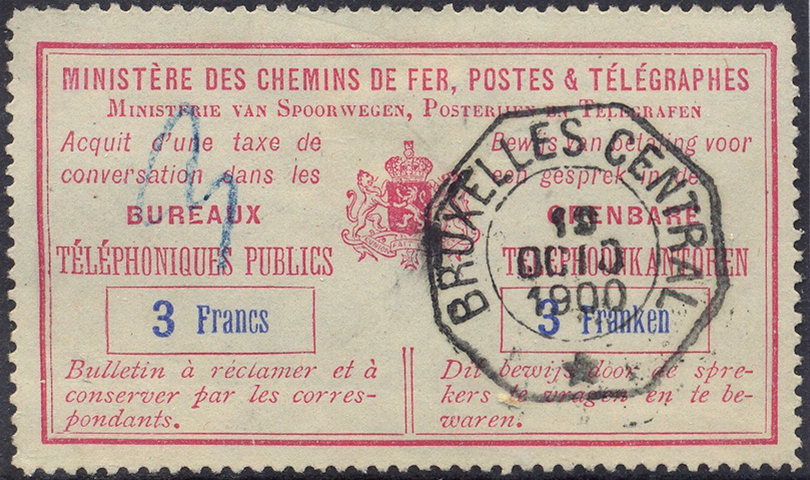

Two more examples from RL.
The tête-bêche pairs mentioned in Hiscocks' Note.1 look like this.

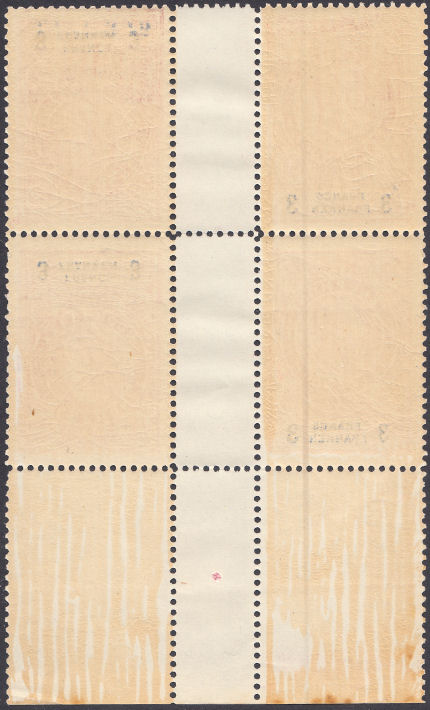
The (half-size) back shows that the gum appears to have been applied by brush leaving the gutter un-gummed.
These are also known imperforate. They differ from the issued stamps in that the values are written differently.
These are perhaps proofs or colour trials.
 |
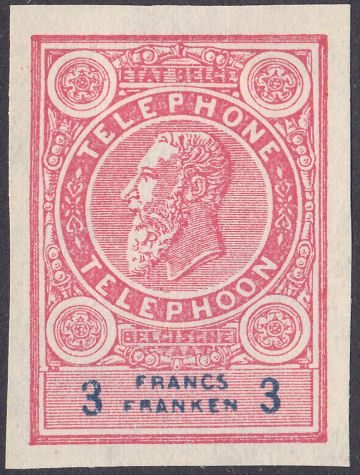 |
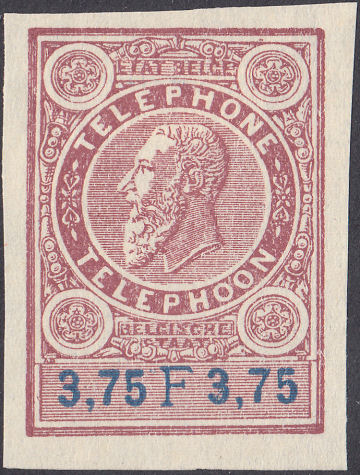 |
| H2 proof ? |
H7 proof ? |
H8 proof ? |
| |
 |
 |
 |
| H2 as issued. |
H7 as issued. |
H8 as issued. |
Again, these are also available as tête-bêche pairs (without gum), with or without values.
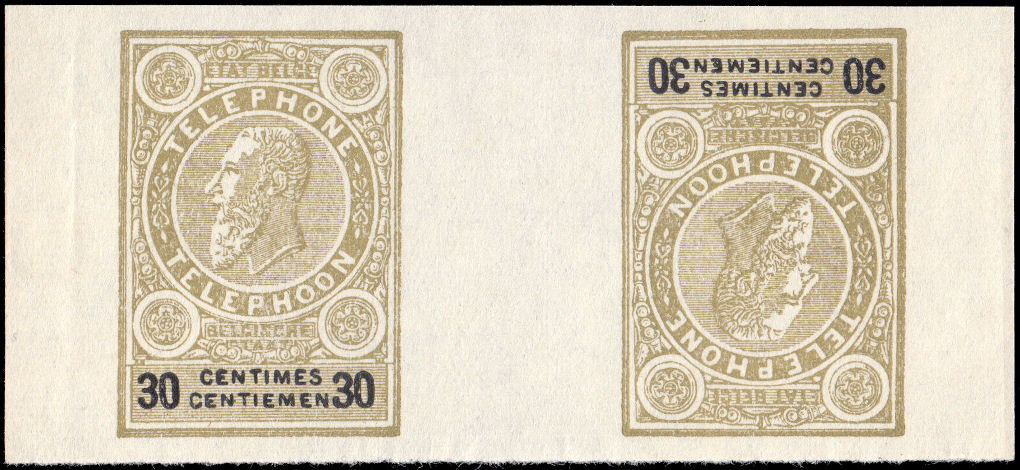
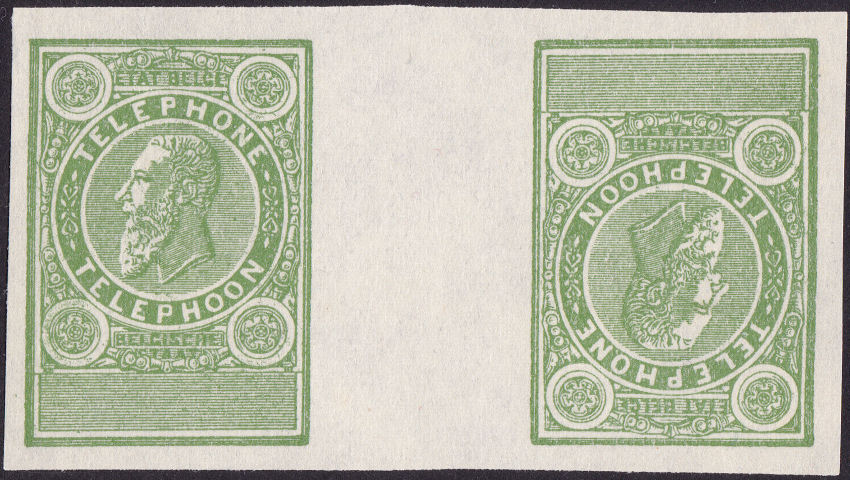
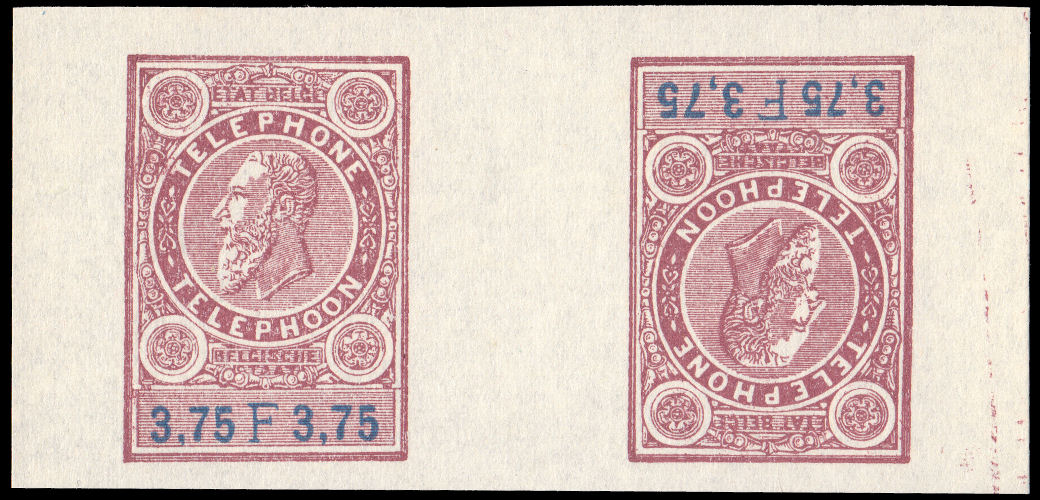
Stationery.
Télégraphie Sans Fil.
Head Office (Siège Social) at 13, Rue Bréderode, Bruxelles.
Apparently set up in 1913, and important in World War 1. "Sans Fil" means literally "without wires", or wireless.
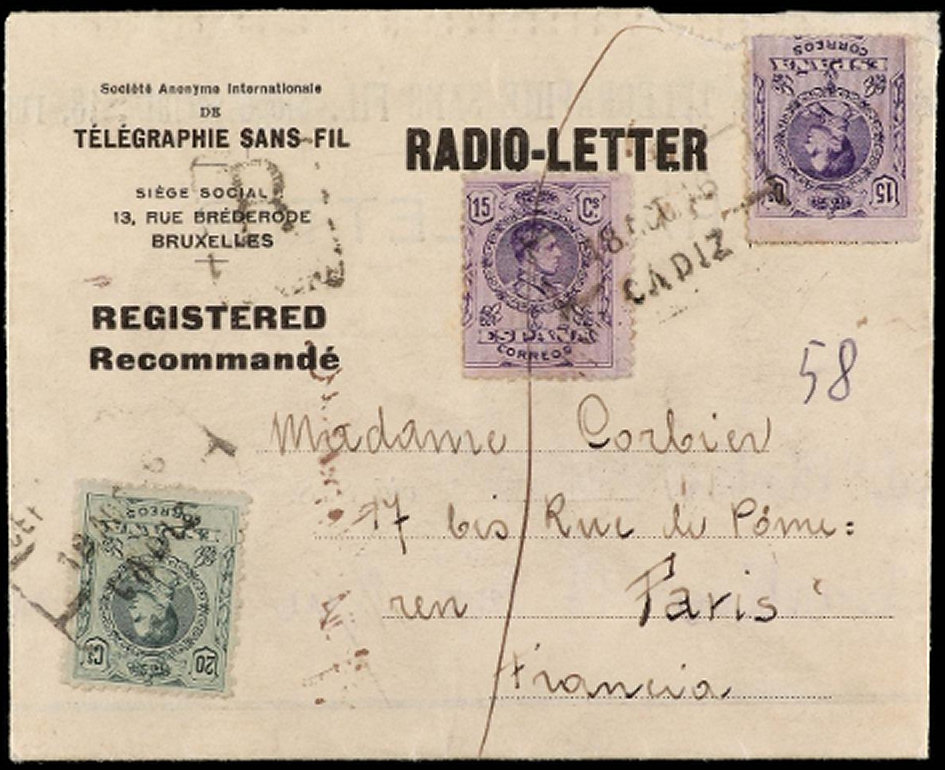
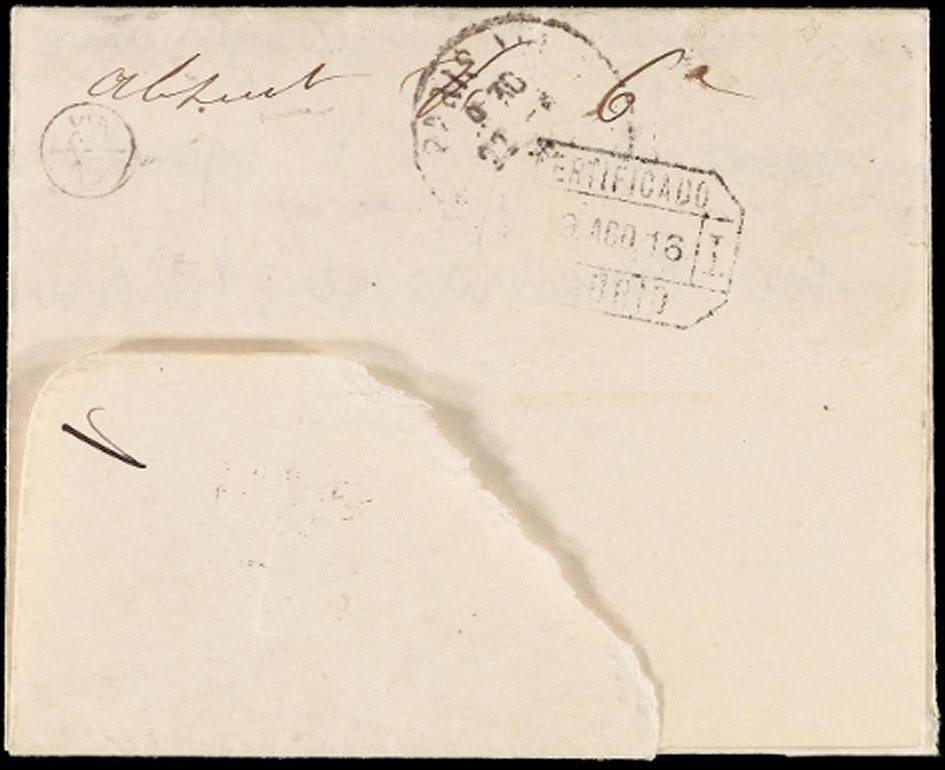
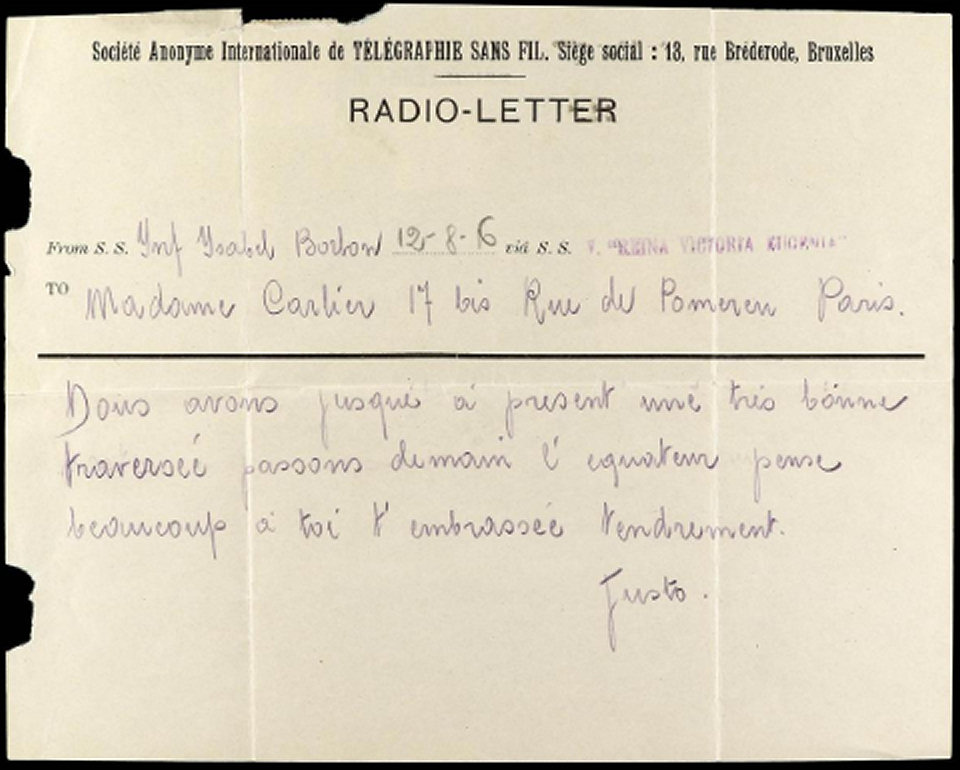
This was sent by radio on 12 August 1916 from the Steam Ship "Reina Victoria Eugenia", and received at Cadiz, Spain. It was sent by Registered mail on 18 August via Madrid on the 19th, to Paris where it arrived on the 22nd.
An example transmitted from the S.S. Thysville on 12 March 1931, received at Antwerp and mailed to Brussels.
Images courtesy of vgstamps2015 on eBay (click image for listing).
 |
 |
The envelope is marked "Ocean Letter" and has "Form. T.7145" at bottom-left.
 |
The contents, also marked "Ocean Letter", has a pre-filled date of "192_" and has "Form. T.7144" at top-left.
 |
Telegram used 11 March 1880.

There is an "imprint" up the left side.

This reads "L'État n'est soumis à aucune responsibilité à raison du service de la correspondance privée par voie télégraphique (Loi du 1er Mars 1854, Art. 6)."
Or in English : "The State is not subject to any responsibility due to the service of private correspondence by telegraph (Law of March 1, 1854, Art. 6)."
A standard disclaimer, but note the word "Loi" in French meaning Law ("wet" in Flemish) what follows is an enabling date, not the date of printing the telegram.
Telegram used in 1888, now with parts also in Flemish.

There is an "imprint" up the left side.

As last, except now in French and Flemish.
Telegram used 23 August 1892, a complete bi-lingual redesign with a space for a date-stamp.
There is a space at the top for "Indications of Service" and an explanation on the right of codes "D.", "RP.", "CR." and "XP."

Telegram used 24 April 1896, with an additional note on "services taxés" and wider central section.

Telegram used 14 February 1898. I think this is late use, as it appears to be intermediate between the 1892 and 1896 telegrams above.
As can be seen, it is incomplete.

Telegram used 15 September 1903. Another complete re-design.

Telegram used 18 June 1908. Very similar to last, but spaced out vertically.
The Indications and message sections have more height.

Telegram Form G No. 70
Telegram used 28 June 1906. Another re-arrangement.

There is now an incomplete imprint visible up the left side with "... Bon 17-1904." and the printers name and address for Mertens & Sons.

I take the 1904 as being the year of printing.
Telegram used 29 June 1907. Just like the last, but with the imprint on the right.

This imprint up the right side is more complete with "Série G, no 7.— Bon 17-1904." and the printers name and address for Mertens & Sons in Brussels.

I take the 1904 as being the year of printing. "Bon" is Flemish for Voucher.
Telegram printed 1919 and used 30 December 1920. Similar to last, but code "CR" replaced with "PC" and "PCP".
Now referencing Telephones at top-left.

The imprint up the left side ireads "Série G, no 7A.— Lot 1 Cdc 517 de 1919.—V. Ghiesbreght."
I take V. Ghiesbreght as being the printing company and the 1919 as being the year of printing.

Telegram printed 1927 and used 21 July 1934. Now without "PCP", but where would it go?

The imprint up the left side reads "Série (Reeks) G, no 7. — Bon 674. — 1927. — M. V. C. V. Gand.". Reeks is Flemish for Series.
I take M. V. C. V. as being the printing company, though "Gand" could be the surname or the place, Ghent. I take 1927 as being the year of printing.

Telegram printed 1927 and used 26 July 1945! This with "P" at top-right. Was that meant to be the "indications" ?
Now using strips.

The imprint up the left side is partly covered, but looks the same as the last one, reading "Série (Reeks) G, no 7. — Bon 674. — 1927. — M. V. C. V. Gand."
I take 1927 as being the year of printing.

Telegram printed 1929 and used 2 March 1931 This is like the 1927 type, but with advertisements on the back.

The imprint up the left side reads "Série (Reeks) G, n. 7 — Bon 736 — 1929. — EVRARD, FRANIÈRE."
I take 1929 as being the year of printing, and the printer being Evrard in Franière.

The back has advertisements for companies in Bruxelles

Telegram printed 1929 and used 19 March 1931 This is similar to the last, but with different advertisements and printer.

The imprint up the left side reads "Série (Reeks) G, no 7. — Bon 736. — 1929. — Volksdrukkerij, Gand."
I take 1929 as being the year of printing, and the printer being Volksdrukkerij in Ghent.

The back has advertisements for companies operating not only in Bruxelles

Telegram printed 1929 and used in 1931 This is similar to the last two, but again with different advertisements and printer.
This also shows part of something removed from the right.

The imprint up the left side reads "Série (Reeks) G, no 7. — Bon 736 de 1929. — Imp. Moniteur belge, 1929 7476. "
I take 1929 as being the year of printing, and the printer being Moniteur belge.

The back has an advertisements for Electrolux.

Telegram printed 1933 and used 27 July 1936.
Now "RÉGIE" at top-left rather than Administration. Nothing printed on the back.

The imprint up the left side reads "Série (Reeks) G, no 7. — Bon 9/391-1933. — Breuer."
I take 1933 as being the year of printing by Breuer.

French only Telegram printed 1940 and used 23 July 1945.

The imprint up the left side reads "TG 7 FR. (Ex G 7 FR.)— Bon 13/347-1940. — Vandeweghe."
I take the "FR" to indicate a French only printing, 1940 as being the year of printing by Van de Weghe.

French only Telegram of 1945, used 26 November 1945.
An expanded range of "Indications"

The imprint up the left side is in an unusual style, reading "TG7FR(Bon 57-45).-".
I take the "FR" to indicate a French only printing, and the 45 to indicate a year of 1945.

French only Telegram used 10 December 1949.

The imprint up the left side reads "TG 7 (FR) — Imp. HAVAUX. Nivelles."
I take the "FR" to indicate a French only printing, by Havaux in Nivelles. No indication of date of printing.

French only Telegram used 22 November 1960.
An expanded range of "Indications"

The imprint up the left side is partly obscured, but probably reads "TG 7 Fr - Imp. HAVAUX. Nivelles.", similar to above.
I take the "FR" to indicate a French only printing, by Havaux in Nivelles. No indication of date of printing.

Law of 13-10-1930 - "Reproduction interdite"
It seems strange that they had been printing telegrams for nearly 30 years without thinking to mention this before.
I don't know the full extent of the law, but it includes a prohibition on the copying of telegram forms, since they then had the following "Copying forbidden" imprints :


The equivalent, "Nadruk verboden" is on the Flemish only form below. It is on Dutch Form 17 from 1916, though with no law reference.
French only Telegram used 6 April 1957. With "AUTG" at top-right.
Indications of ELT, LT and RP. Law of 1930.

The imprint up the left side refers to the law of 1930.

French only Telegram used 22 November 1963. Worded the same as the last, but heading larger and imprint smaller.
Indications of ELT, LT and RP. Law of 1930.

The imprint up the left side refers to the law of 1930.

Flemish only double-sided Telegram printed 1969 and used 3 October 1973.
Indications of ELT, LT and RP. Law of 1930.

The imprint up the left side refers to the law of 1930.

The back has "Nuttige Wenken Voor De Gebruikers" or "Useful Tips For The Users".

There is an informative imprint up the left side suggesting a date of printing of 1969.

Telephone Forms.
Form G No. 70
For Telegrams delivered by telephone and charged by the word.
A form used at St. Ghislain, printed in 1893 and used 30 June 1895.

The imprint at bottom-right reads "Série G, no 70.— Bon no 51-1893"

Form G No. 71
For Telephone calls, charged by the minute.
A form used at St. Ghislain, printed in 1893 and used 30 June 1895.

The imprint at bottom-right reads "Série G, no 71. — Bon no 50-1893"

A larger, revised form used at St. Ghislain, printed in 1896 and used 31 August 1897.

The imprint at bottom-right reads "Série G, no 71. — Bon no 110 of 1896."

A compound item of two different types of forms, 71 and 72, joined together with a seal, used January 1906.
This is headed "Communications téléphoniques taxées demandées pendant le mois dernier." meaning "Taxed telephone communications requested during the last month."

The imprint at bottom-left reads "Série G 71. — Bon 20-1904. — Imp. Ve Mertens et Fils. Bruxelles."

Back of pair, sideways, showing the back of the G72 form.

Carefully opening the pair out to show the back of the G71 and front of the G72 :
This is the back of the G71 form.

This is the front of the G72 form.
It is headed "Télégrams échangées par téléphone pendant le mois dernier." meaning "Telegrams exchanged by phone during the last month." It is by the number of words.

The imprint at bottom-left reads "Série G 72. — Bon 20-1904. — Imp. Ve Ad. Mertens et Fils, Bruxelles."

Form TF. 74
Headed "Correspondances échangées par téléphone pendant le mois dernier." meaning :
"Correspondence exchanged by phone during the last month."
A form used at Mechelen (Malines), printed in 1924 and used 6 October 1925.

The imprint at bottom-right side reads "TF. 74. — Bon 274-1924. — G. Piquart."


The back has a bi-lingual datestamp of 10 October 1925.
Miscellaneous.
An interesting item dated 1 January 1903.


That is not an actual seal on it, it is printed there. This is a telegram delivered by potcard. The message "Mes meilleurs vœux de nouvel an." means "My best wishes for the New year."
The octagonal cancel is typically telegraphic. It was sent to arrive on the first of January.
A similar item of 1919. Printed 5c for the postcard, plus 25c to Jemappes.
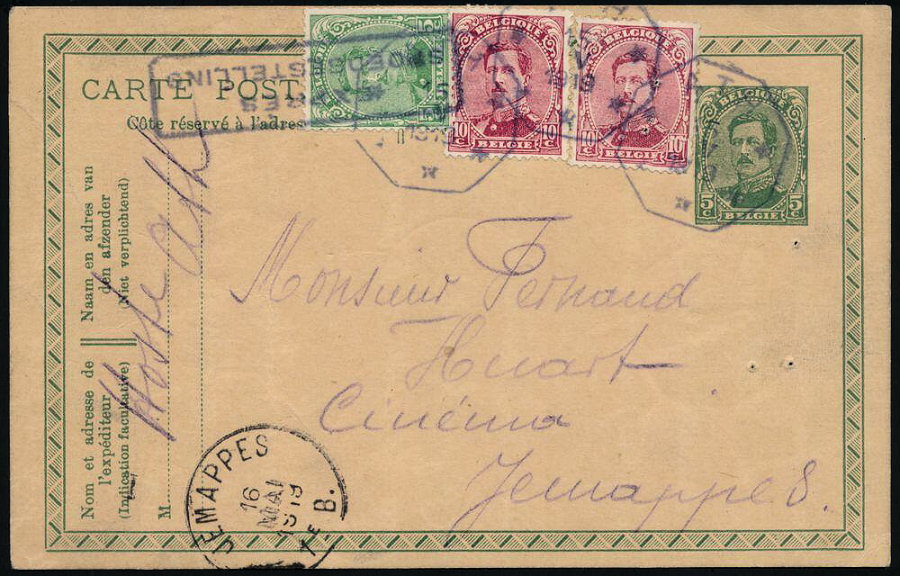
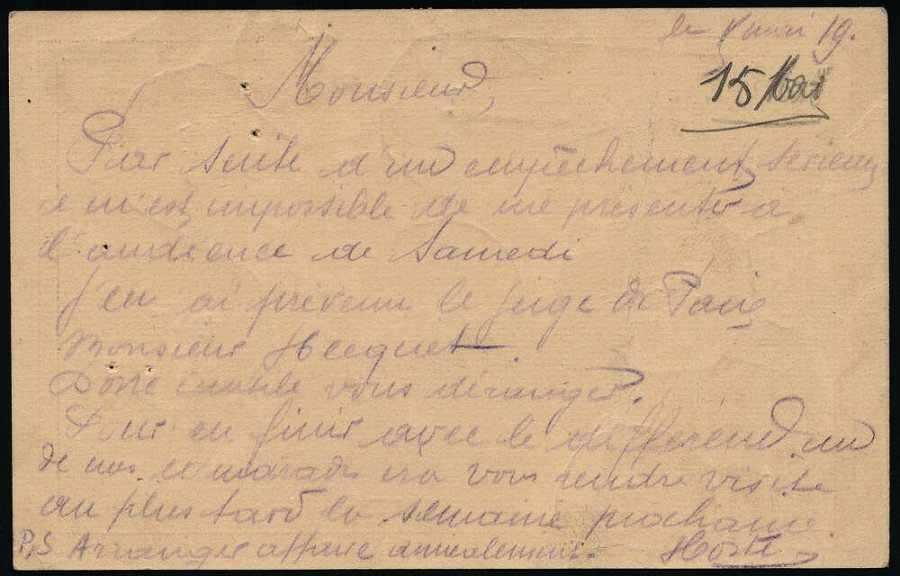
 |

The octagonal cancel has "ATH" and the date, 15 V 1919.
A box at top left has "EXPRESS / SPOEDBESTELLING" meaning "Express / Special delivery"
Images and information courtesy of Van Looy & Van Looy
|
An envelope used in 1914 by a German soldier writing home. The Belgium markings, were defaced, but the envelope is still interesting.


A Telephone receipt of 1897 in French and Flemish, used at Verviers.

100Fr for Abonnement (Subscription).
A receipt of 1916 marked "No 516".

An undated envelope of sometime after about 1936. "Liefdadigheidstelegram" means "Charity Telegram".


A later Philanthropic version in colour.
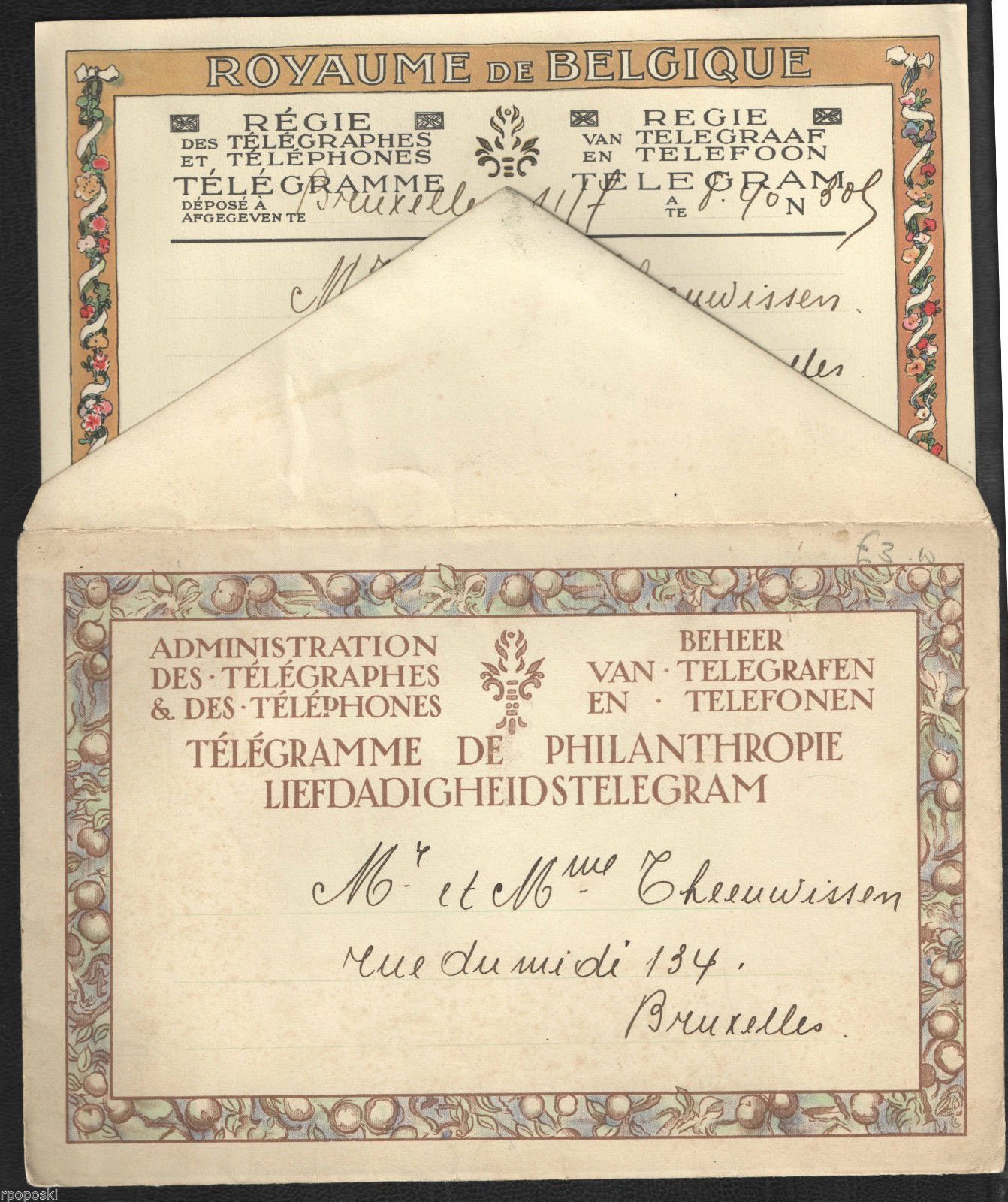
Image courtesy of Robert Poposki.
This is a large "231" envelope that has little to do with telegraphy other than "Telegraphes" is mentioned
It is for parcel delivery. The boxed "Aftekening is vereist voor aangetekende expressezendingen." at the top means "Signature is required for registered express shipments."
The sideways "In te vullen door het kantoor van herkomst." below means "To be filled in by the Office of origin."
"Dagtekeningstempel van de kantoren die tijdens het vervoer tussenkomen." at the bottom means "Date stamp of the offices that intervene during transport."

Marked "1976" at the bottom.
Telegram Seals.
Belgium used a large quantity of similar, but different seals over the years.
Click image below to see more:

Belgian State.
Belgian Congo.
1913, Belgian Congo, telegraph service, postage-free administrative envelope, sent from Leopoldville April 4, 1913 to Boma where it arrived April 10, 1913.
The "T" mark may have been stamped in error, unless (like in Puerto Rico) the postal workers, not having been told what it was for, used it on Telegrams.
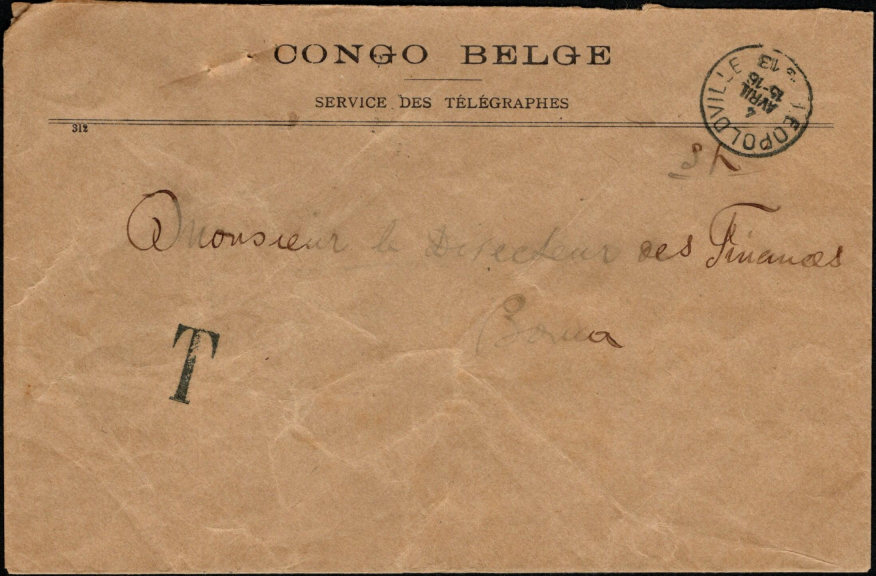
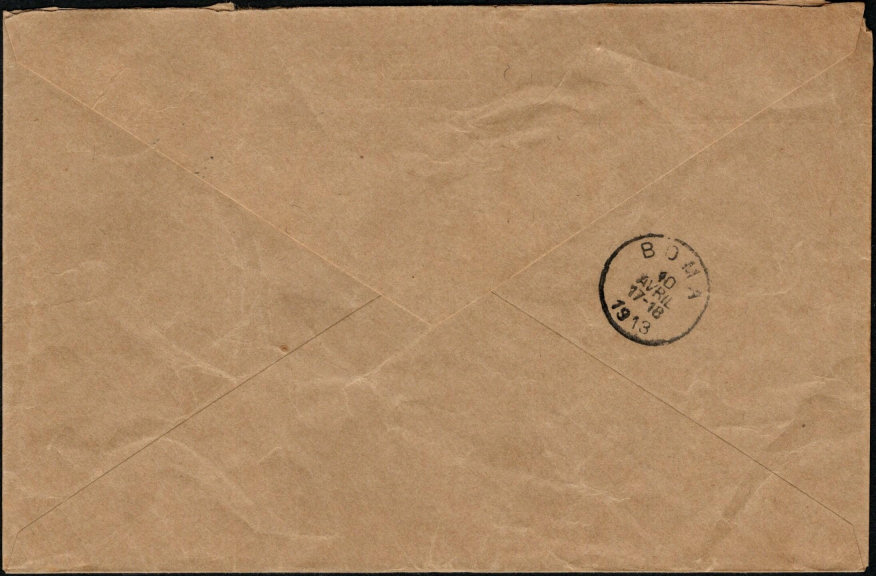
An imprint on the left of the front identified the envelope with the number 312

Images courtesy of Lindekens Auctions
Form 2/T dated 20 February 1925.
 |
 |
|
An imprint at bottom-left has "No 2/T. — 1063."
This was used at Boma in Belgian Congo, for a telegraphic message from Stanleyville received Feb. 20, 1925.
The blue closure seal is unusual.
There are 9 codes for different "indications of service".
Images courtesy of Lindekens Auctions |
Form Mod. 2/T. dated 19 April 1946.
 |
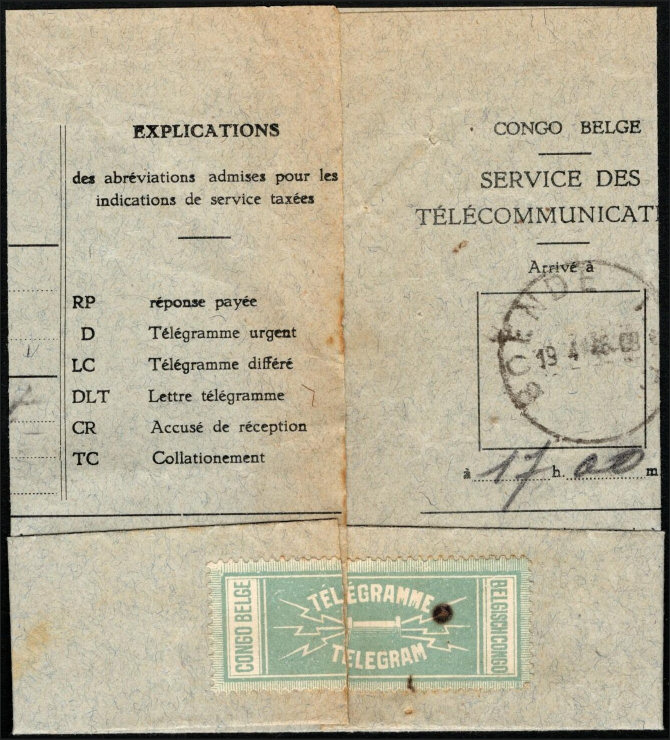 |
|
No visible imprint at bottom, but "Mod. 2/T."
visible and large at the top.
A BOENDE T.S.F. Telegraphic cancel dated 19 April 1946, for a message from Coquilhatville.
This with a green closure seal.
Now only 6 codes for different "indications of service".
Images courtesy of Lindekens Auctions |
A form used in Elizabethville in 1960.
The Congo used seals similar to those in Belgium, but in green.
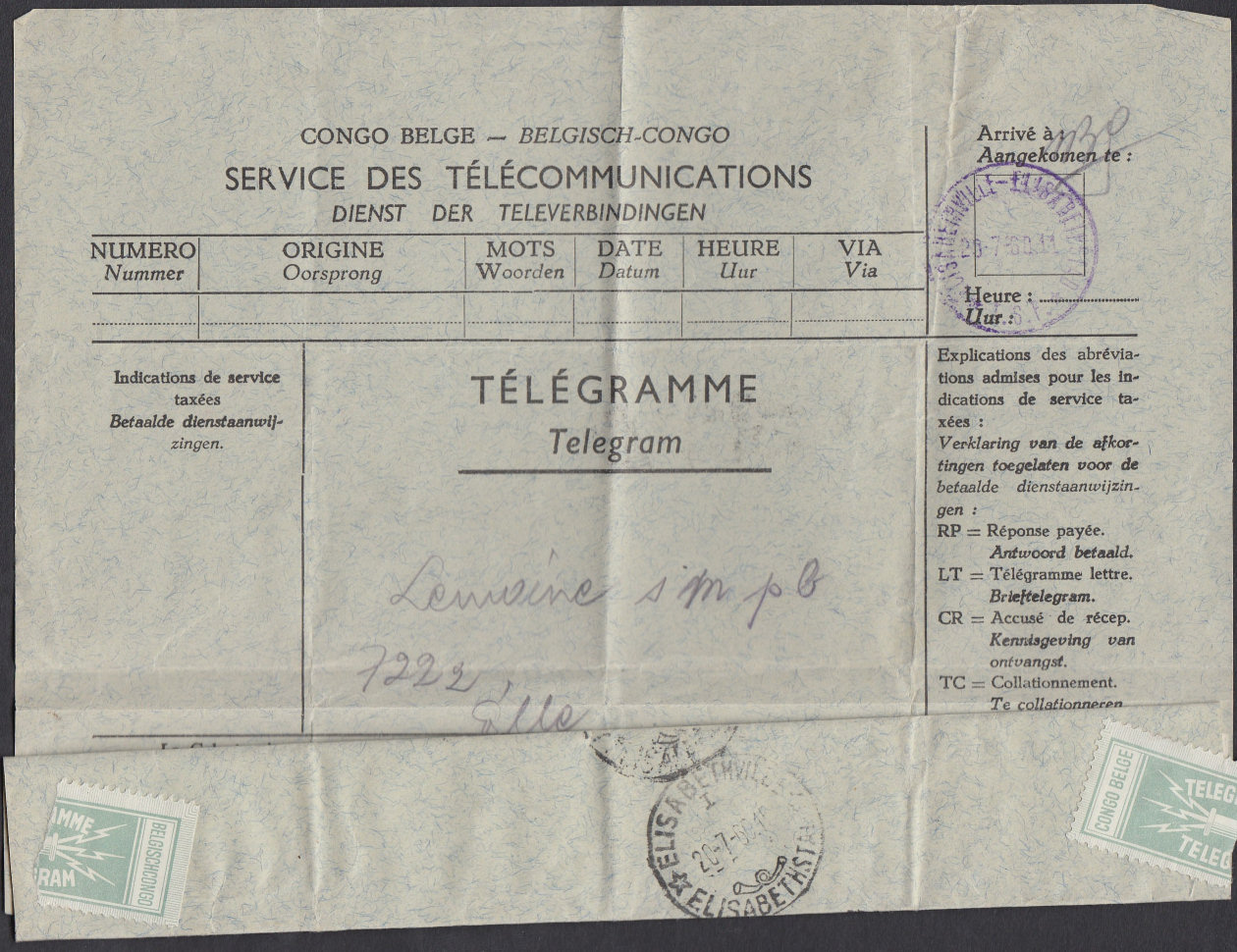
It looks like a covered imprint at the bottom-left.

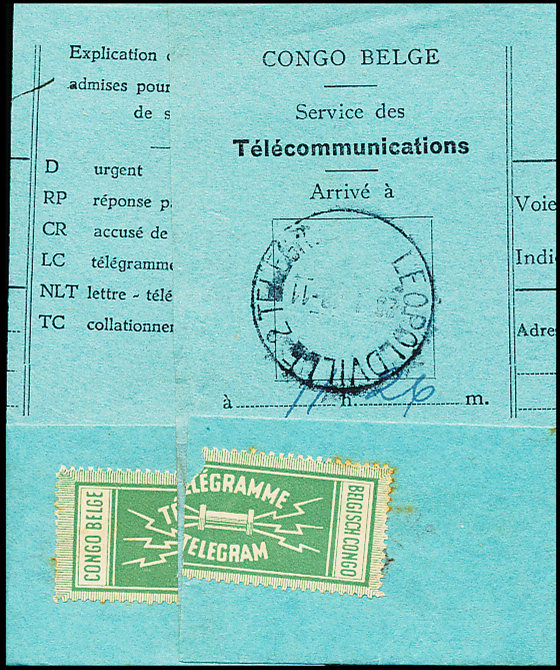
A couple of folded forms used in Leopoldville, the first used in 1943, the other from the 1948.

Belgian Congo seal, courtesy of Robert Poposki.
Steve Hiscocks made a start on cataloguing seals of the world in a book he published in 2007.
It was his hope to update it later, but unfortunately that was not to be.
His original book can be viewed at
Telegraph Seals: A World Catalogue. There are links from the pages to my updates.
Alternatively you can view the latest page for Belgium .
Comments, criticisms, information or suggestions are always welcome.

Please include the word 'Telegraphs' in the subject.
Last updated 1st. September 2025
©Copyright Steve Panting 2012/13/14/15/16/17/18/19/20/21/22/23/24/25 except where stated.
Permission is hereby granted to copy material for which the copyright is owned by myself, on condition that any data is not altered and this website is given credit.


